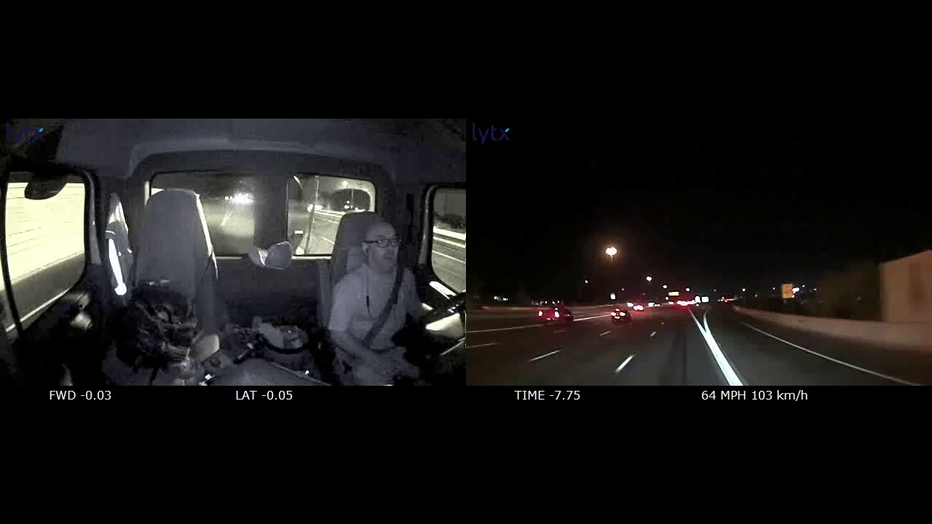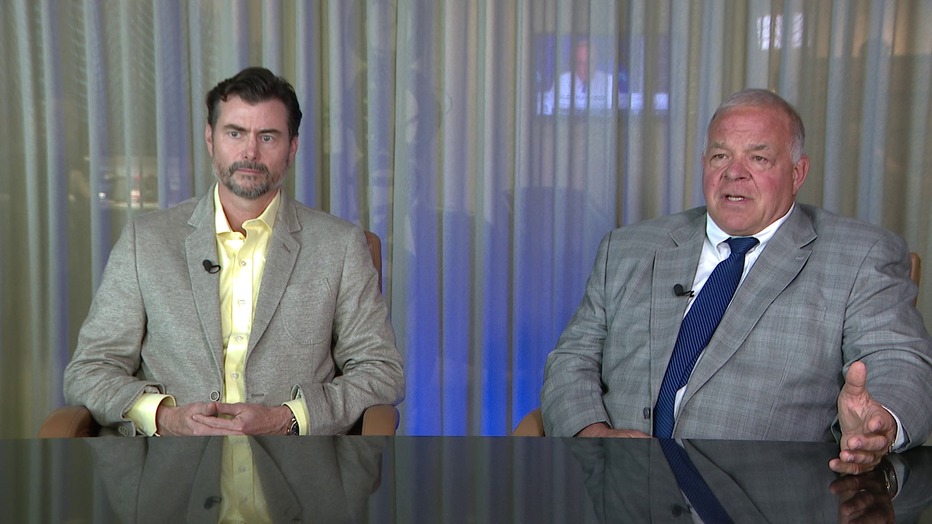Fatal fatigue: Loophole allows specific truckers to drive beyond time limits

Loophole allows some truckers to drive beyond time limits
In the wake of a fatal crash in 2021 on a Phoenix highway, we're looking into potential regulatory gaps that may contribute to fatigue among semi-truck drivers transporting agricultural commodities. We want to warn you ? the footage in this story is hard to watch. FOX 10 Justin Lum has this investigative report.
PHOENIX - Fatigue on the freeway is leading to deadly driving.
It’s an epidemic in the trucking industry, causing crashes and sometimes, costing lives.
FOX 10 Investigates looked into how drivers in a certain sector are more prone to be overworked and under-rested.
Several killed in 2021 crash
It was a tragedy that happened in Phoenix back in 2021.
Four dead and 11 injured in an eight-vehicle crash caused by a milk tanker truck on Loop 202 near Van Buren Street.
What happened?
National Transportation Safety Board (NTSB) findings reveal the driver of the truck was fatigued.
We’re learning more about a loophole allowing certain carriers to drive beyond the time limit allowed – unregulated.
Four people were pronounced dead at the scene.
- 35-year-old Sedeqwa Keyara-Parker of Phoenix
- 21-year-old Alexius Hooper of Phoenix
- 20-year-old Dante Brubeck-Vanderslice of Casa Grande
- 20-year-old Jennifer Vidal of Casa Grande
'He was everything to me’
"Every time I come here and visit, it’s very hard because it takes me back to the day that he was buried. Knowing I can never take my son back out with me, knowing he’ll never come home," Maria Seidenstricker said.
She's the mother of Dante Brubeck-Vanderslice.
"He never wasted a moment of his life. He didn’t take any day for granted," she said.
Dante was the best Christmas present she could ask for. He was the first child to make Maria a mother.
"We did everything together. We grew up together. We shared a lot of good times, bad times, memories, things that we went through. I mean, he was everything to me," she said.
Dante worked as a patient care assistant in the Valley, aspiring to become a registered nurse.
On the night of June 9, 2021, he will be forever 20 years old.
Maria says authorities knocked on her door the next morning.
"He said, ‘It’s all over the news. All over the news. The accident happened,’" she remembered. "The minute I heard that, I felt like I was going to die."
On that night, around 10 p.m., a tank-trailer hauling milk driving eastbound on Loop 202 crashed into the back of Dante’s Ford Fusion.
The sudden collision continued into six other cars, causing some to veer off into the barrier wall. The tanker separated from the truck, crossing over the median into the westbound lanes, bursting into flames.
Dante was driving with three friends on the way to get coffee from Dutch Bros. He and his 20-year-old friend Jennifer Vidal died at the scene.
So did 21-year-old Alexius Hooper and 35-year-old Sedeqwa Keyara-Parker who were in two other cars involved.
"Death won’t keep us apart for our love is forever. Just remember me in your heart and one day we will be together," Maria said to her son while looking at this grave site. "Live your life and live it full. Don’t waste a single day. Remember, I am always with you every step of the way."
FOX 10 obtained footage of the crash from the dash cam inside the truck driver’s cab.

Semi-truck driver in Phoenix right before the deadly crash
"The fact that I had to view my son’s last moments on video really destroyed me inside because they were not doing anything wrong," Maria said.
Investigators say the truck driver was going up to 64 mph, never slowing down, despite a line of cars stopped in front of him.
A chain-reaction crash ensues.
The driver is Cesar Gavonel who worked for Arizona Milk Transport (AMT) since 2008. He had no violations or crashes on his record before this accident, and investigators said impairment was not a factor.
But, something else was a factor.
Arizona Milk Transport’s safety culture called into question
"They had policies and procedures that weren’t followed. They didn’t follow them," said Highway Accident Investigator Michael Fox of the NTSB said at a March 28, 2023, NTSB board meeting.
Nearly two years after the deadly milk tanker crash, the NTSB released its investigation findings in March 2023.
Officials say Arizona Milk Transport’s safety culture was inadequate and the drivers had dozens of events including cell phone use detected on the drive cam system. Rarely was there discipline or coaching to improve driver behavior.
"77% of the events on drive cam didn’t even have a driver assigned to it. They had one driver who had 128 events in ten months. That is very unacceptable, so we found many flaws with their safety culture," Fox said at the meeting.
As for the tanker driver, Cesar Gavonel, he was reprimanded several months before the crash for cell phone use but not disciplined a month prior to the crash for the same issue.
Findings revealed he worked 13-14 hour days and arrived home increasingly later on the three nights leading up to the accident, getting about five to six hours of sleep opportunity.
The NTSB says driver fatigue caused the crash.
CLICK HERE TO READ THE NTSB'S FINDINGS REPORT
According to the Commercial Vehicle Safety Alliance, the top violation for drivers in North America is "hours of service."
The hours of service regulation was intended to limit the number of hours a driver can operate to prevent fatigue.
Commercial truck drivers carrying property can drive a maximum of eleven hours within a 14-hour period and should not drive more than 60 hours in a seven-day period.
In this case, there’s an issue that the NTSB Board Chair called ridiculous.
AMT operates under a federal agricultural hours-of-service exemption, meaning driving hours are unlimited within a 150 air-mile radius if a truck carries agricultural commodities, like milk.
Hours of service
"The problem is, dairy is a year-round harvesting if you will, so it doesn’t appear that the exemption really fits, at least why I understand the purpose of that exemption to be," said Bob Boatman, a shareholder with Gallagher & Kennedy.
Boatman and Shannon Clark are two of the lawyers representing victims of the milk tanker crash in the lawsuit against AMT.
"Let’s say I haul raw milk. I have an exemption and when I leave the 150-mile radius, what happens? What kicks in?" asked NTSB Board Chair Hon. Jennifer Homendy.
An investigator responds, "Then the hours-of-service kicks in, but you can be operating all day long, Chair Homendy, all day. You could be working a 15-hour day or whatever and then you leave the circle, the bubble, and then the clock begins. So that’s very troubling."

Lawyers Shannon Clark and Bob Boatman
‘…gap in the law…'
"How do we have law, or should I say, exemption law, that allows people to drive that many hours unlimited within a 150-mile radius?" Maria asked.
There’s no track of specific data linked to the agricultural exemption.
"So, we don’t have data on the safety impact of hours-of-service exemptions and FMCSA has no means of obtaining such data. The extent of the potential increased risk of fatigued driving and the industries exempt from hours of service regulation and associated crash rate is unknown at this time," said NTSB Board member Hon. Michael E. Graham.
The data doesn't exist at the federal level or state level.
FOX 10 checked the most recent crash statistics released by the Arizona Department of Transportation.
There are several categories including motor vehicle types, fatalities, weather and lighting conditions, age groups, alcohol factors and even license statuses. But data related to agricultural commodities wasn't found.
"You can work a lot of hours and a substantial number of them might not count towards your total hours worked essentially under federal law. I mean, that’s astounding to me and then we don’t even know apparently who’s doing that," said NTSB Board Chair Homendy.
NTSB investigators reviewed a 30-day span of timesheets, learning that Gavonel, the driver involved in the deadly crash, regularly worked more than his self-reported hours. Instead, he worked over 83 hours one week and 77 hours another week within a month before he crashed.
Several other drivers did not follow policy and NTSB says these drivers are paid for every load of milk transported – not by the hour.
AMT did not have a standalone fatigue policy and did not mention the agricultural exemption.
"Clearly, this case is a good example of how that type of gap in the law can cause problems," said Clark, a lawyer for the victims. "So we would hope that this would be an example that Congress could look at and say, ‘Hey, maybe we need to take another look at that.'"
‘Disaster waiting to happen again’
"To me, it’s a disaster waiting to happen again," Maria said.
She wants justice for her son.
Despite Arizona's Department of Public Safety submitting a charge of manslaughter to the Maricopa County Attorney’s Office, prosecutors declined to file, citing no reasonable likelihood of conviction.
"It’s quite sad for me and all the other victims as well, because in my opinion, all the facts and findings are there," Maria said.
The defendants, including AMT and United Dairymen of Arizona, reached a settlement with Maria and the rest of the plaintiffs.
FOX 10 reached out to all the defendants’ lawyers for comment and have not heard back.
Boatman and his team have now filed suit against the manufacturer of the truck involved in the crash.
"All he needed is the simple warning that’s now in virtually every vehicle, and we believe this accident never happened," the attorney said.
The claim against Daimler Truck North America is that Daimler did not install collision avoidance technology for the truck sold to AMT prior to 2018.
The tech includes an obstacle detection system and lane departure warning system – safety features Clark says could have prevented a tragedy.
"The reality is that the technology was there and to not offer it in this situation where you have what represents probably one of the most devastating things that can happen on the road, just makes no sense," Clark said.
Daimler has not responded to our request for a comment.
What's next
Meanwhile, Maria copes with the loss of her first-born and visits his gravesite just to be close to him.
In April 2023, NTSB recommended to the Federal Motor Carrier Safety Administration (FMCSA) to develop and implement a program to determine the prevalence of for-hire motor carriers operating under the agricultural hours of service exemption and study safety performance linked to fatigue related crashes and management.
FOX 10 reached out to FMCSA which operates under the U.S. Department of Transportation. We wanted to know if the ag exemption will be addressed.
Here’s what we learned – since 1995, FMCSA has the authority to modify or revoke the exemption if the agency determines that the exemption is not in the public interest and has a significant impact on safety.
Due to the fact that there is limited information on individual drivers’ miles while transporting agricultural commodities, FMCSA is unable to satisfy the statutory criteria to modify or revoke the exemption.

